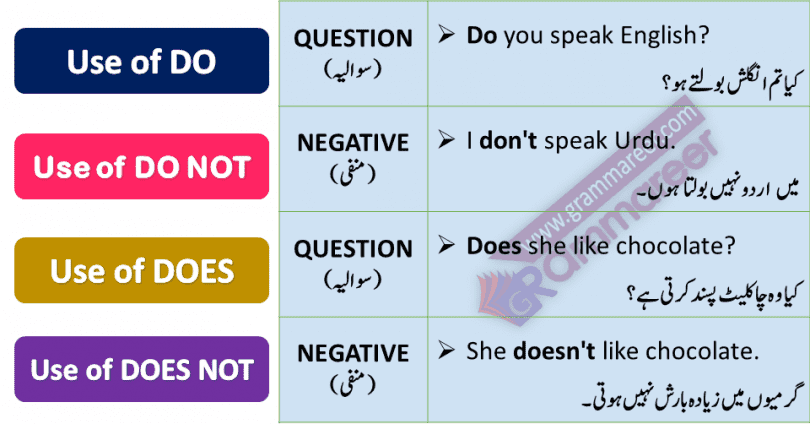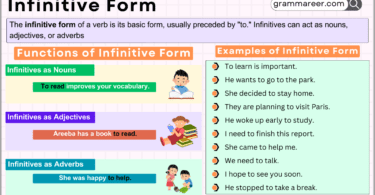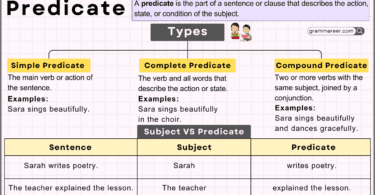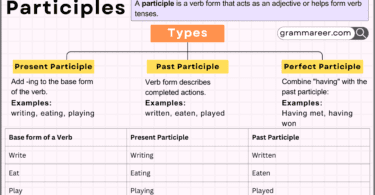Understanding the use of DO, DOES, DON’T and DOESN’T is essential for forming correct questions and negative sentences in English. These helping verbs often confuse beginners, especially when switching between singular and plural subjects. In this blog post, we break down their meanings and usage in both English and Urdu for easy learning.
To improve your grammar skills, visit our grammar section.
Table of Contents
Use of DO, DOES, DON’T and DOESN’T
The use of DO, DOES, DON’T, and DOESN’T is essential for forming correct questions and negative sentences in English. These auxiliary verbs help us create grammatically correct structures, especially in the present simple tense.
✅When to Use DO and DOES
We use DO and DOES to form questions in the present simple tense.
| Subject | Auxiliary Verb |
|---|---|
| I, You, We, They | DO |
| He, She, It | DOES |
📊 Word Order for Questions
| Helping Verb | Subject | Base Verb | Example |
|---|---|---|---|
| DO | I, We, You, They | play | Do you play hockey? |
| DOES | He, She, It | take | Does he take dinner? |
Examples with DO:
- Do you play cricket?
کیا آپ کرکٹ کھیلتے ہیں؟ - Do they know the answer?
کیا وہ جواب جانتے ہیں؟ - Do we have class today?
کیا آج ہماری کلاس ہے؟ - Do I look tired?
کیا میں تھکا ہوا لگ رہا ہوں؟ - Do children like cartoons?
کیا بچوں کو کارٹون پسند ہیں؟
Examples with DOES:
- Does he work in an office?
کیا وہ دفتر میں کام کرتا ہے؟ - Does she go to college?
کیا وہ کالج جاتی ہے؟ - Does it make sense?
کیا یہ سمجھ میں آتا ہے؟ - Does Ali speak English?
کیا علی انگلش بولتا ہے؟ - Does your brother play football?
کیا تمہارا بھائی فٹبال کھیلتا ہے؟
Rule: Verb Without S in Questions
When we form a question with DO or DOES, the main verb stays in its base form. If the affirmative sentence ends in -s or -es (e.g., He speaks), the s disappears in the question form (e.g., Does he speak?).
❌When NOT to Use DO or DOES
We do not use DO or DOES in questions when the main verb is:
- A form of To Be (is, am, are)
- A Modal Verb (can, should, must, might, etc.)
✅When to Use DON’T and DOESN’T
To make negative sentences in the present simple tense, we use DON’T and DOESN’T:
| Subject | Negative Form |
|---|---|
| I, You, We, They | DON’T |
| He, She, It | DOESN’T |
🧱 Structure of Negative Sentences
| Subject | Helping Verb | Base Verb | Example |
|---|---|---|---|
| I, We, You, They | DON’T | play | They don’t play hockey. |
| He, She, It | DOESN’T | take | She doesn’t take dinner. |
DON’T = Do not
DOESN’T = Does not
Examples with DON’T:
- I don’t eat spicy food.
میں تیز مصالحے والا کھانا نہیں کھاتا۔ - You don’t understand me.
تم مجھے نہیں سمجھتے ہو۔ - We don’t live here.
ہم یہاں نہیں رہتے۔ - They don’t go to school.
وہ اسکول نہیں جاتے۔ - I don’t like loud music.
مجھے اونچی آواز میں موسیقی پسند نہیں ہے۔
Examples with DOESN’T:
- He doesn’t watch TV.
وہ ٹی وی نہیں دیکھتا۔ - She doesn’t eat meat.
وہ گوشت نہیں کھاتی۔ - It doesn’t work properly.
یہ صحیح کام نہیں کرتا۔ - Ali doesn’t know the way.
علی راستہ نہیں جانتا۔ - The child doesn’t cry.
بچہ نہیں روتا ہے۔
Summary
- Use DO with I, You, We, They.
- Use DOES with He, She, It.
- Use DON’T for negative sentences with plural subjects.
- Use DOESN’T for negative sentences with singular subjects.
- Don’t use DO/DOES with To Be or Modal Verbs.
Mastering these rules will help you speak and write correct English with confidence. For more learning, explore our grammar section.
You May Also Like





